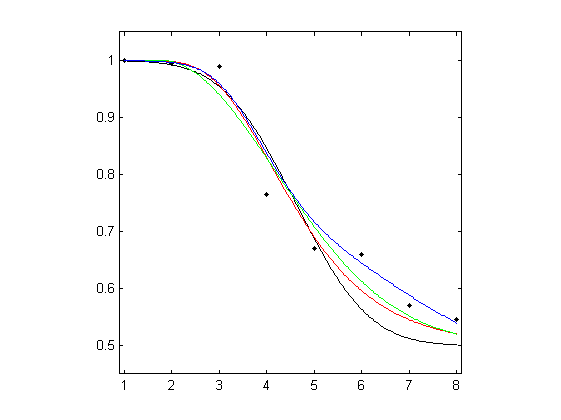
 |
Model-free estimation of a psychometric function |
|---|---|
| Home | Downloads | Demonstration | Documentation | Examples | Functions | Contacts |
|---|
Nascimento, S.M.C., Foster, D.H., & Amano, K. “Psychophysical estimates of the number of spectral-reflectance basis functions needed to reproduce natural scenes”, Journal of the Optical Society of America A-Optics Image Science and Vision, 22 (6), 1017-1022, 2005.
MatLab R The subject was shown an image of a natural scene and an approximation of this image based on principal component analysis. The task was to distinguish between the images. The symbols in the figure below show the proportion of correct responses as a function of number of components in the approximation. There were 200 trials at each level pooled over a range of natural scenes.
Parametric and local linear fitting
Three different parametric models and the local linear fitting are used and fits are plotted against the measured psychometric data. Three different parametric models are fitted to these data: Gaussian (probit), Weibull, and reverse Weibull. Local linear fitting is also performed with the bandwidth
bwdchosen by the minimising cross-validated deviance.Load the data and plot the measured psychometric data (black dots), as follows. Notice that in the same example in Żychaluk and Foster (2009) Download PDF, the x-axis was reversed.
clear, load examples/Nascimento_etal;
figure; plot( x, r ./ m, 'k.'); axis([0.9 8.1 0.45 1.05]); axis square;1. For the Gaussian cumulative distribution function (black curve):
degpol = 1; % Degree of the polynomial
guessing = 1/2; % guessing rate
lapsing = 0; % lapsing rate
b = binomfit_lims( r, m, x, degpol, 'probit', guessing, lapsing );
numxfit = 199; % Number of new points to be generated minus 1
xfit = [min(x):(max(x)-min(x))/numxfit:max( x ) ]';
% Plot the fitted curve
pfit = binomval_lims( b, xfit, 'probit', guessing, lapsing );
hold on, plot( xfit, pfit, 'k' );2. For the Weibull function (red curve):
initK = 2; % Initial power parameter in Weibull/reverse Weibull model
[ b, K ] = binom_weib( r, m, x, degpol, initK, guessing, lapsing);
% Plot the fitted curve
pfit = binomval_lims( b, xfit, 'weibull', guessing, lapsing, K );
hold on, plot( xfit, pfit, 'r' );3. For the reverse Weibull function (green curve):
[ b, K ] = binom_revweib( r, m, x, degpol, initK, guessing, lapsing);
% Plot the fitted curve
pfit = binomval_lims( b, xfit, 'revweibull', guessing, lapsing, K );
hold on, plot( xfit, pfit, 'g' );4. For the local linear fit (blue curve):
bwd_min = -min( diff( x ) ); % data is decreasing
bwd_max = max( x ) - min( x );
bwd = bandwidth_cross_validation( r, m, x, [ bwd_min, bwd_max ] );
% Plot the fitted curve
bwd = bwd(3); %choose the third estimate, which is based on cross-validated deviance
pfit = locglmfit( xfit, r, m, x, bwd );
hold on, plot( xfit, pfit, 'b' );